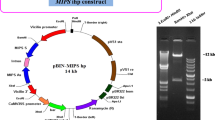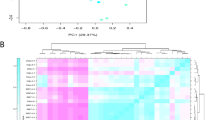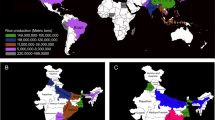Abstract
Phytic acid in cereal grains and oilseeds is poorly digested by monogastric animals and negatively affects animal nutrition and the environment. However, breeding programs involving mutants with less phytic acid and more inorganic phosphate (Pi) have been frustrated by undesirable agronomic characteristics associated with the phytic acid-reducing mutations. We show that maize lpa1 mutants are defective in a multidrug resistance-associated protein (MRP) ATP-binding cassette (ABC) transporter that is expressed most highly in embryos, but also in immature endosperm, germinating seed and vegetative tissues. Silencing expression of this transporter in an embryo-specific manner produced low-phytic-acid, high-Pi transgenic maize seeds that germinate normally and do not show any significant reduction in seed dry weight. This dominant transgenic approach obviates the need for incorporating recessive lpa1 mutations to create maize hybrids with reduced phytic acid. Suppressing the homologous soybean MRP gene also generated low-phytic-acid seed, suggesting that the strategy might be feasible for many crops.
This is a preview of subscription content, access via your institution
Access options
Subscribe to this journal
Receive 12 print issues and online access
$209.00 per year
only $17.42 per issue
Buy this article
- Purchase on Springer Link
- Instant access to full article PDF
Prices may be subject to local taxes which are calculated during checkout





Similar content being viewed by others
References
Lott, J.N.A., Ockenden, I., Raboy, V. & Batten, G.D. Phytic acid and phosphorus in crop seeds and fruits: a global estimate. Seed Sci. Res. 10, 11–33 (2000).
Nelson, T.S., Shieh, T.R., Wodzinski, R.J. & Ware, J.H. The availability of phytate phosphorus in soybean meal before and after treatment with a mold phytase. Poult. Sci. 47, 1842–1848 (1968).
Cromwell, G.L. & Coffey, R.D. Phosphorus—a key essential nutrient, yet a possible major pollutant—its central role in animal nutrition. in Biotechnology in the Feed Industry (ed. Lyons, T.P.) 133–145 (Alltech Tech Publishers, Nicholasville, Kentucky, USA, 1991).
Corell, D.L. The role of phosphorus in the eutrophication of receiving waters: a review. J. Environ. Qual. 27, 261–266 (1989).
Selle, P.H., Ravindran, V., Bryden, W.L. & Scott, T. Influence of dietary phytate and exogenous phytase on amino acid digestibility in poultry: a review. J. Poult. Sci. 43, 89–103 (2006).
Reddy, N.R., Pierson, M.D., Sathe, S.K. & Salunkhe, D.K. Nutritional consequences of phytates. in Phytates in Cereals and Legumes (eds. Reddy, N.R., Pierson, M.D., Sathe, S.K. & Salunkhe, D.K.) 81–110 (CRC Press, Inc., Boca Raton, Florida, USA, 1989).
Bohlke, R.A., Thaler, R.C. & Stein, H.H. Calcium, phosphorus, and amino acid digestibility in low-phytate corn, normal corn, and soybean meal by growing pigs. J. Anim. Sci. 83, 2396–2403 (2005).
Golovan, S.P. et al. Pigs expressing salivary phytase produce low-phosphorus manure. Nat. Biotechnol. 19, 741–745 (2001).
Raboy, V. Seeds for a better future: 'low phytate' grains help to overcome malnutrition and reduce pollution. Trends Plant Sci. 6, 458–462 (2001).
Li, Y.C., Ledoux, D.R., Veum, T.L., Raboy, V. & Ertl, D.S. Effects of low phytic acid corn on phosphorus utilization, performance, and bone mineralization in broiler chicks. Poult. Sci. 79, 1444–1450 (2000).
Spencer, J.D., Allee, G.L. & Sauber, T.E. Phosphorus bioavailability and digestibility of normal and genetically modified low-phytate corn for pigs. J. Anim. Sci. 78, 675–681 (2000).
Jang, D.A. et al. Evaluation of low-phytate corn and barley on broiler chick performance. Poult. Sci. 82, 1914–1924 (2003).
Ertl, D.S., Young, K.A. & Raboy, V. Plant genetic approaches to phosphorus management in agricultural production. J. Environ. Qual. 27, 299–304 (1998).
Sugiura, S.H., Raboy, V., Young, K.A., Dong, F.M. & Hardy, R.W. Availability of phosphorus and trace minerals in low-phytate varieties of barley and corn for rainbow trout (Oncorhynchus mykiss). Aquaculture 170, 285–296 (1998).
Sands, J.S. et al. Phosphorus bioavailability, growth performance, and nutrient balance in pigs fed high available phosphorus corn and phytase. J. Anim. Sci. 79, 2134–2142 (2001).
Mendoza, C. et al. Effect of genetically modified, low-phytic acid maize on absorption of iron from tortillas. Am. J. Clin. Nutr. 68, 1123–1128 (1998).
Hambidge, K.M. et al. Zinc absorption from low-phytate hybrids of maize and their wild-type isohybrids. Am. J. Clin. Nutr. 79, 1053–1059 (2004).
Hambidge, K.M. et al. Absorption of calcium from tortilla meals prepared from low-phytate maize. Am. J. Clin. Nutr. 82, 84–87 (2005).
Raboy, V. et al. Origin and seed phenotype of maize low phytic acid 1–1 and low phytic acid 2–1. Plant Physiol. 124, 355–368 (2000).
Pilu, R., Landoni, M., Cassani, E., Doria, E. & Nielsen, E. The maize lpa241 mutation causes a remarkable variability of expression and some pleiotropic effects. Crop Sci. 45, 2096–2105 (2005).
Bregitzer, P.P. & Raboy, V. Effects of four independent low-phytate mutations on barley (Hordeum vulgare L.) agronomic performance. Crop Sci. 46, 1318–1322 (2006).
Meis, S.J., Fehr, W.R. & Schnebly, S.R. Seed source effect on field emergence of soybean lines with reduced phytate and raffinose saccharides. Crop Sci. 43, 1336–1339 (2003).
Shi, J., Wang, H., Hazebroek, J., Ertl, D.S. & Harp, T. The maize low-phytic acid 3 encodes a myo-inositol kinase that plays a role in phytic acid biosynthesis in developing seeds. Plant J. 42, 708–719 (2005).
Shi, J. et al. The maize low-phytic acid mutant lpa2 is caused by mutation in an inositol phosphate kinase gene. Plant Physiol. 131, 507–515 (2003).
Muszynski, M.G. et al. Delayed flowering1 encodes a basic leucine zipper protein that mediates floral inductive signals at the shoot apex in maize. Plant Physiol. 142, 1523–1536 (2006).
Goodman, C.D., Casati, P. & Walbot, V. A multidrug resistance-associated protein involved in anthocyanin transport in Zea mays. Plant Cell 16, 1812–1826 (2004).
Gaedeke, N. et al. The Arabidopsisthaliana ABC transporter AtMRP5 controls root development and stomata movement. EMBO J. 20, 1875–1887 (2001).
Klein, M., Burla, B. & Martinoia, E. The multidrug resistance-associated protein (MRP/ABCC) subfamily of ATP-binding cassette transporters in plants. FEBS Lett. 580, 1112–1122 (2006).
Brenner, S. et al. Gene expression analysis by massively parallel signature sequencing (MPSS) on microbead arrays. Nat. Biotechnol. 18, 630–634 (2000).
Jofuku, K.D. & Goldberg, R.B. Kunitz trypsin inhibitor genes are differentially expressed during the soybean life cycle and in transformed tobacco plants. Plant Cell 1, 1079–1093 (1989).
Belanger, F.C. & Kriz, A.L. Molecular characterization of the major maize embryo globulin encoded by the Glb1 gene. Plant Physiol. 91, 636–643 (1989).
Lin, L., Ockenden, I. & Lott, J.N.A. The concentrations and distribution of phytic acid-phosphorus and other mineral nutrients in wild-type and low phytic acid1–1 (lpa1–1) corn (Zea mays L.) grains and grain parts. Can. J. Bot. 83, 131–141 (2005).
Preiss, J. Modulation of starch synthesis. in A Molecular Approach to Primary Metabolism in Higher Plants (eds. Foyer, C.H. and Quick, W.P.) 81–104 (Taylor and Francis, London, 1997).
Aalen, R.B. The transcripts encoding two oleosin isoforms are both present in the aleurone and in the embryo of barley (Hordeum vulgare L.) seeds. Plant Mol. Biol. 28, 583–588 (1995).
Greenwood, J.S. & Bewley, J.D. Subcellular distribution of phytin in the endosperm of developing castor bean: a possibility for its synthesis in the cytoplasm prior to deposition within protein bodies. Planta 160, 113–120 (1984).
Otegui, M.S., Capp, R. & Staehelin, L.A. Developing seeds of Arabidopsis store different minerals in two types of vacuoles and in the endoplasmic reticulum. Plant Cell 14, 1311–1327 (2002).
Stevenson-Paulik, J., Bastidas, R.J., Chiou, S.T., Frye, R.A. & York, J.D. Generation of phytate-free seeds in Arabidopsis through disruption of inositol polyphosphate kinases. Proc. Natl. Acad. Sci. USA 102, 12612–12617 (2005).
Brunner, S., Fengler, K., Morgante, M., Tingey, S. & Rafalski, A. Evolution of DNA sequence nonhomologies among maize inbreds. Plant Cell 17, 343–360 (2005).
Ishida, Y. et al. High efficiency transformation of maize (Zea mays L.) mediated by Agrobacterium tumefaciens. Nat. Biotechnol. 14, 745–750 (1996).
Christensen, A.H., Sharrock, R.A. & Quail, P.H. Maize polyubiquitin genes: structure, thermal perturbation of expression and transcript splicing, and promoter activity following transfer to protoplasts by electroporation. Plant Mol. Biol. 18, 675–689 (1992).
An, G. et al. Functional analysis of the 3′ control region of the potato wound-inducible proteinase inhibitor II gene. Plant Cell 1, 115–122 (1989).
Belanger, F.C. & Kriz, A.L. Molecular basis for allelic polymorphism of the maize Globulin-1gene. Genetics 129, 863–872 (1991).
Zhao, Z.Y. et al. High throughput genetic transformation mediated by Agrobacterium tumefaciens in maize. Mol. Breed. 8, 323–333 (2001).
Damude, H.G. et al. Identification of bifunctional delta12/omega3 fatty acid desaturases for improving the ratio of omega3 to omega6 fatty acids in microbes and plants. Proc. Natl. Acad. Sci. USA 103, 9446–9451 (2006).
Heppard, E.P., Kinney, A.J., Stecca, K.L. & Miao, G.H. Developmental and growth temperature regulation of two different microsomal omega-6 desaturase genes in soybeans. Plant Physiol. 110, 311–319 (1996).
Finer, J. & McMullen, M. Transformation of soybean via particle bombardment of embryogenic suspension culture tissue. In Vitro Cell. Dev. Biol. 27, 175–182 (1991).
Acknowledgements
The lpa1-1 mutant was kindly provided by V. Raboy (USDA-ARS, National Small Grain Germplasm Research Facility, Aberdeen, ID). BAC clone sequencing and assembly was conducted by Pioneer Crop Genetics Research and Development sequencing laboratory. We thank Jan Hazebroek, Jessica Holland, Ryan Wally and Lisa Hagen for technical assistance, Russ Booth and Cheryl Caster for soybean transformation, and Doug Nubel, Marjorie Rudert, Shifu Zhen and Andrew Waber for assistance in the field and the greenhouse. We are grateful to Mitchell Tarczynski, Rudolf Jung and Bill Hitz for discussions.
Author information
Authors and Affiliations
Contributions
J.S. conceived and directed the project, wrote the manuscript and identified the lpa1-mum1 mutant; H.W. performed molecular characterization of MRP4; K.S. analyzed the maize transgenic lines with supervision by J.S.; B.L. identified the TAP marker; J.M.S. constructed the soybean transformation vector and analyzed the soybean transformants; J.P.R. generated the maize transgenic lines; K.G. constructed the maize transformation vectors; H.W., J.S., R.B.M. and D.S.E. identified the lpa1 Mu insertion alleles; J.S., B.L., M.F., H.W. and K.S. performed fine mapping and cloning.
Corresponding author
Ethics declarations
Competing interests
The authors declare no competing financial interests.
Supplementary information
Supplementary Text and Figures
Supplementary Figures 1–4 and Supplementary Tables 1 and 2 (PDF 312 kb)
Rights and permissions
About this article
Cite this article
Shi, J., Wang, H., Schellin, K. et al. Embryo-specific silencing of a transporter reduces phytic acid content of maize and soybean seeds. Nat Biotechnol 25, 930–937 (2007). https://doi.org/10.1038/nbt1322
Received:
Accepted:
Published:
Issue Date:
DOI: https://doi.org/10.1038/nbt1322
This article is cited by
-
An Overview of Targeted Genome Editing Strategies for Reducing the Biosynthesis of Phytic Acid: an Anti-nutrient in Crop Plants
Molecular Biotechnology (2024)
-
Emerging roles of inositol pyrophosphates in signaling plant phosphorus status and phytohormone signaling
Plant and Soil (2023)
-
Low phytate soybean: next generation metabolic engineering using CRISPR-Cas 9 genome editing technology
Journal of Plant Biochemistry and Biotechnology (2023)
-
Advances in improvement of soybean seed composition traits using genetic, genomic and biotechnological approaches
Euphytica (2022)
-
An insight into phytic acid biosynthesis and its reduction strategies to improve mineral bioavailability
The Nucleus (2022)



